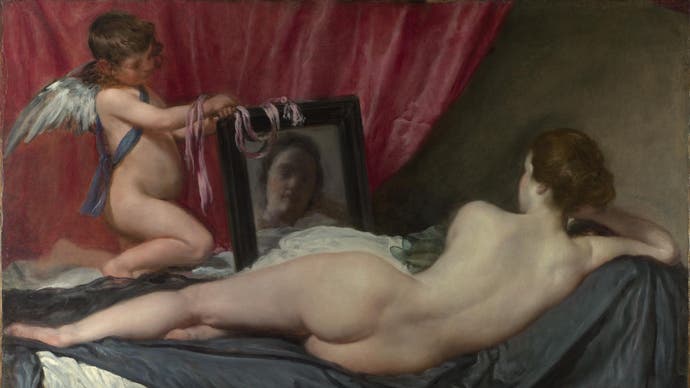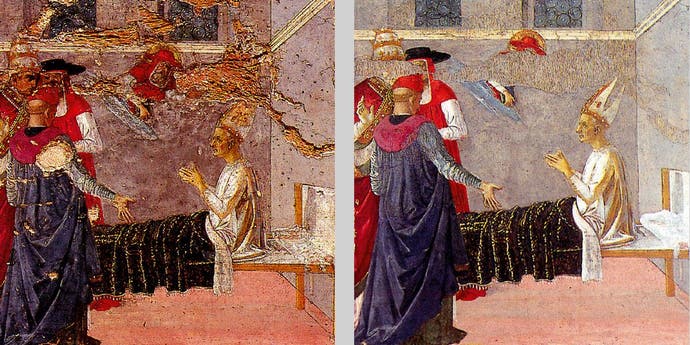Someone should make a game about: art restoration
Completionist.
Hello, and welcome to our new series which picks out interesting things that we'd love someone to make a game about.
This isn't a chance for us to pretend we're game designers, more an opportunity to celebrate the range of subjects games can tackle and the sorts of things that seem filled with glorious gamey promise.
Check out our 'Someone should make a game about' archive for all our pieces so far.
Venus, the goddess of love, reclines on her bed, while her son Cupid holds up a mirror. She gazes into it, but her reflection is blurred and cast in shadow. We cannot see who she really is. Velazquez implores us to conjure our own image of beauty, and to complete the image ourselves.

Velazquez has this unrivalled ability to paint a scene as if he's recalled it from a foggy dream. He applies each brush stroke with such efficiency, and with such thin paint, the Rokeby Venus barely appears to exist. At first, our eyes are automatically drawn to Venus, Cupid and the mirror, but look closely and you'll notice Cupid's back foot and Venus' left foot are mere silhouettes. Cupid's wings are comprised of simple sweeps, and even the complex drapery has this same ephemeral quality, as if it could fade away at a moment's notice.
Stare hard at Venus' form and you'd never suspect a thing. To even the most eagle-eyed viewer, everything is as it seems. Go on, lean in and put your ear to the image. Hear that? It's the soft chuckle of the National Gallery's chief restorer Helmut Ruhemann.

On 10th March 1914, the suffragette Mary Richardson wandered into the National Gallery and slashed Velazquez's canvas with a meat cleaver (a story for another time, but certainly worth looking into). As you can see, she left the painting with seven severe gashes, all of which were beautifully restored by Ruhemann.
This is a prime example of 'deceptive' restoration and it's certainly the most popular method of art restoration in this day and age. I recently visited the National Gallery to see the Rokeby Venus in the flesh, and had I been totally unaware of its history, it would've been almost impossible to tell it had once been so violently butchered. If I peered very closely, I could just make out her scars, lighter in tone and remarkably true to life.
In other words, art restoration is fascinating. And it's a complex business, too - even before you pick up a brush.
I'd be willing to bet many of us think of the Rokeby Venus restoration as nothing short of stunning. Well, to someone like Cesare Brandi, this 'invisible' in-painting completely defiles the original. He'd think of it as horrid forgery, corrupting the very nature of the work.
So what sort of restoration would he propose then? Well, take a look at the image below.

This is from Pietro Perugino's Scenes from the Life of St Jerome (1495). On the left side we see it during cleaning, and on the right, after restoration. I know what you're thinking - it's bizarre, and it looks as if the restorer has carefully laid the foundations but hasn't finished the job. This is actually Brandi's ideal form of art restoration, something called tratteggio, or as it's sometimes termed, rigatino.
Both of these words translate loosely to "little line" in Italian, and if we look closer it's clear to see why. The restorer has woven hundreds - if not thousands - of vertical lines together, each of "pure" hue (unmixed colour) and with a single flick of the wrist. They coalesce to form a pixelated haze of static, but one which breaks apart the key shades of the piece and scatters them carefully before us. There's a ribbed quality to the restored areas too, as if swiftly running the tip of your fingernail along its textured surface would produce a sharp "bzzzt" sound.
At its heart, tratteggio honours a work of art's journey. Its many years hanging pride of place in the king's bedroom, its jagged descent from a flame-licked window, its cold, dank days in an abandoned wine cellar, and its nervy unfurling to a hushed crowd. "We must remember what has been lost.", Brandi would say, and point to all that's missing. To him these aren't flaws, but experiences which have shaped the work's identity.
Sure, the original artist won't have painted the piece with intentions of it falling into ruin, but with each brush stroke they breathed life into it. This, I think is the key to understanding tratteggio. A work of art transcends its "physical thingness" and becomes almost living.
What's fascinating - and I think quietly game-like - is the multi-dimensional quality to tratteggio. From afar the fuzz appears to form a blurred whole, so we're able to witness the artist's vision and the story they're telling. As we move closer, the lines come into focus, allowing us to see the marks of time, yet never distracting from the artist's unique touch. It creates this sense that you've peeled a very thin layer off the canvas, and you're staring at a swirling collection of memories.

Matrera Castle's restoration provoked a vicious response upon its unveiling in 2015. Some called it a "massacre", and others even claimed it brought "shame to Spain". Admittedly, it's not hard to see why many would recoil at the sight of an ageing castle propped up by a seemingly blank crutch. In their minds, they pictured themselves wandering through the dusty hallways of this once magnificent fortress, climbing its towers and getting a sense of what it may have been like back in Medieval times. To them, it should have been entirely rebuilt to resemble the original.
Just as Brandi's philosophy embraces decay, so does Matrera Castle. Some of its crumbled remains have been left untouched, and a strikingly modern screen now acts as a surface which proudly displays what's left of its walls, but also gives us the freedom to piece together what the original structure would've been like. We are given an honest account of its lifetime, and I'm fond of the way it bares itself to the spectator as if it's still here after all these years, happy to share everything it's been through and accepting of the help it's received.
Despite Brandi's philosophy of restoration being an outright rejection of other techniques, it's ironic then, that it's totally grounded in acceptance. Whether you believe it's ugly or not, there's something to be admired in the way it honours art. Rather than stitching a damaged piece back together in a sneaky attempt to undo history, tratteggio helps you learn to let go. What is lost can never be recovered, but it allows us to imagine what might have been.


